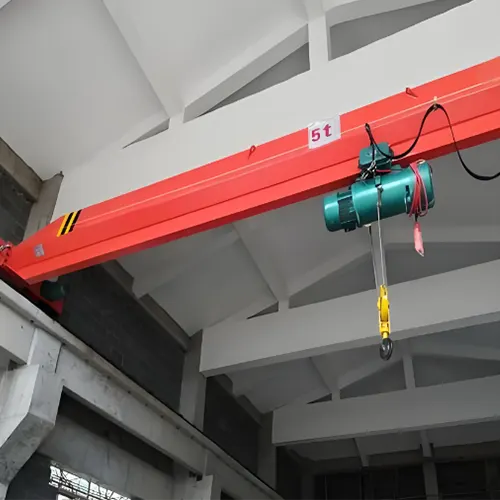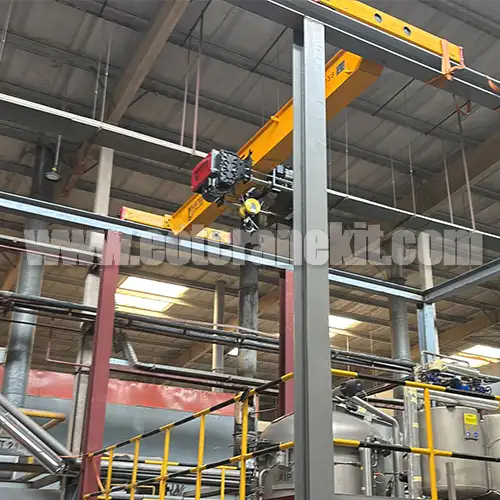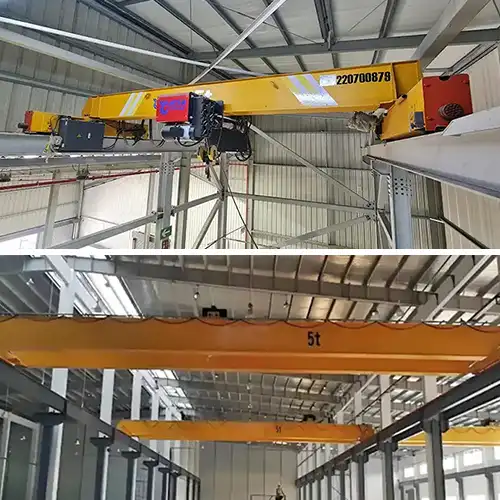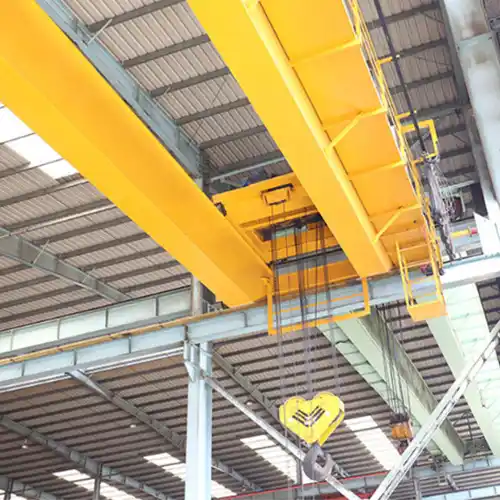How to Get Best Deal: Compare Quotes & Savings on 5 Ton EOT Crane
5 ton eot crane for sale. Effective strategies to compare quotes, negotiate prices, maximize savings when purchasing 5 ton EOT cranes for optimal value.
Category: 5 Ton Overhead Crane
Your Trusted Overhead Eot Crane Manufacturer & Supplier
How to Get Best Deal: Compare Quotes & Savings on 5 Ton EOT Crane
5 ton eot crane for sale. Effective strategies to compare quotes, negotiate prices, maximize savings when purchasing 5 ton EOT cranes for optimal value.
Overview of EOT (Electric Overhead Traveling) Cranes
Electric Overhead Traveling (EOT) cranes are essential equipment used in various industries for lifting and moving heavy loads within a facility. A 5-ton EOT crane, specifically, can handle loads up to 5 metric tons, making it suitable for medium to heavy lifting tasks. These cranes operate on a rail system and consist of a bridge that travels along the length of the rails, with a hoist system mounted on the bridge to lift and lower loads. EOT cranes are known for their efficiency, reliability, and ability to optimize space by utilizing overhead areas.
Procurement of EOT cranes involves significant investment, making cost-saving strategies crucial. Effective cost management ensures that you get the best value for your money while meeting operational needs. By employing strategies to obtain competitive quotes, negotiate better terms, and identify potential savings, you can reduce the overall expenditure. Understanding these strategies not only helps in managing the budget but also enhances the long-term value of the investment by ensuring that the crane meets both performance and financial goals.
5 Ton EOT Cranes for Sale
A 5-ton Electric Overhead Traveling (EOT) crane is a type of crane designed to lift and move loads weighing up to 5 metric tons. This crane is equipped with a robust electric hoist system mounted on a bridge that travels along fixed rails or beams. The bridge, supported by two end trucks, moves horizontally across the length of the rails, while the hoist system moves vertically to lift and lower the load. EOT cranes are typically powered by electric motors and use a combination of gears, pulleys, and chains to perform lifting operations. They are designed for precision, reliability, and high performance in various industrial settings.
LD Single Girder Electric Overhead Traveling Cranes (EOT Crane)
Overview: Single girder electric overhead traveling cranes are commonly used for their versatility and efficiency in various industrial settings. These cranes feature a single girder design with electric hoists for lifting operations. They are suitable for general lifting tasks in warehouses, factories, and assembly lines.
Key Features:
- Capacity: Up to 5 tons.
- Lifting Mechanism: Electric hoist.
- Usage: Suitable for a wide range of industrial applications.
- Customization: Can be tailored with various controls and safety features.
Advantages:
- Reliable and straightforward operation.
- Cost-effective for standard lifting needs.
- Widely available with various options and upgrades.
Disadvantages:May not be ideal for very low headroom environments or specialized applications without further customization.

Low Headroom Single Girder Overhead Crane 5 Tons
Overview: Low headroom single girder overhead cranes are specifically designed to operate in environments where vertical space is limited. They are engineered to maximize lifting height by minimizing the space taken up by the crane's structure.
Key Features:
- Capacity: Up to 5 tons.
- Design: Compact design with reduced headroom.
- Usage: Ideal for facilities with low ceilings or confined spaces.
- Customization: Often comes with features that allow for precise control and efficient space utilization.
Advantages:
- Maximizes lifting height in restricted environments.
- Efficient use of vertical space.
- Enhanced flexibility for installations in low-clearance areas.
Disadvantages:
- May have limitations in terms of load capacity and span compared to standard models.
- Potentially higher initial costs due to specialized design.

FEM/DIN Type Single Girder Overhead Crane 5 Tons
Overview: FEM/DIN type single girder overhead cranes are designed according to European FEM (Federation Européenne de la Manutention) or German DIN (Deutsches Institut für Normung) standards. They are built to meet rigorous engineering and safety requirements.
Key Features:
- Capacity: Up to 5 tons.
- Standards: Designed to comply with FEM or DIN standards.
- Usage: Suited for industries with high standards for performance and safety.
- Customization: Available with advanced features and compliance options.
Advantages:
- High quality and reliability due to adherence to stringent standards.
- Enhanced safety features and engineering precision.
- Suitable for high-demand industrial environments.
Disadvantages:
- Generally more expensive due to adherence to international standards and advanced design.
- May require specific installation and maintenance practices to meet standards.

Typical Applications and Benefits
Applications:
- Manufacturing Plants: In manufacturing facilities, 5-ton EOT cranes are used for lifting and transporting heavy components and raw materials. They facilitate efficient assembly and production processes by moving materials between workstations.
- Warehousing and Distribution: These cranes are essential for managing large inventories in warehouses, helping to move and organize goods quickly and safely.
- Construction Sites: On construction sites, 5-ton EOT cranes assist in lifting and positioning heavy building materials, equipment, and machinery.
- Maintenance and Repair: EOT cranes are often used for maintenance tasks, such as lifting and replacing machinery parts or performing repairs on large equipment.
Benefits:
- Space Optimization: By operating overhead, EOT cranes utilize vertical space, freeing up floor space for other activities. This is particularly advantageous in facilities with limited ground area.
- Enhanced Efficiency: The ability to move loads quickly and precisely reduces downtime and enhances overall operational efficiency. This is crucial for maintaining smooth production and logistics processes.
- Improved Safety: EOT cranes are designed with safety features such as load limiters, emergency stop buttons, and safety brakes to prevent accidents and ensure safe operation. They also help reduce manual handling of heavy loads, minimizing the risk of injuries.
- Durability and Reliability: Built to withstand heavy loads and continuous use, EOT cranes are known for their durability and long service life. Proper maintenance further extends their lifespan and ensures consistent performance.
- Versatility: These cranes can be customized with various attachments and features to handle different types of loads and tasks, making them versatile tools for a wide range of industrial applications.
Gathering Quotes
Identifying Potential Suppliers
To effectively gather quotes for a 5-ton EOT crane, start by identifying reputable manufacturers and suppliers with a solid industry reputation. Research companies known for their reliability and quality by examining online reviews, customer testimonials, and industry ratings. Focus on suppliers with a proven track record of delivering high-quality cranes and those holding relevant industry certifications, such as ISO or CE marks. These credentials ensure that the supplier adheres to international quality and safety standards.
Utilize various resources to compile a list of potential suppliers. Online directories, trade associations, and industry forums are valuable for discovering reputable companies. Attending industry trade shows and exhibitions also provides opportunities to interact with suppliers, view their products firsthand, and gather detailed information. Additionally, seek recommendations from industry colleagues or consult with consultants who specialize in crane procurement to identify trusted suppliers.
When evaluating suppliers, consider both local and international options. Local suppliers may offer benefits such as faster delivery times, more straightforward communication, and reduced shipping costs. They are also more accessible for service and support. However, international suppliers might provide competitive pricing, advanced technology, or unique features not available locally. Assess the total cost of ownership, including shipping, import duties, and potential language barriers, to determine the most advantageous option for your specific needs.
Requesting Quotes
After identifying potential suppliers, the next step is to request detailed quotes. Provide comprehensive specifications to ensure that each quote is accurate and comparable. Include essential details such as the crane's lifting capacity (5 tons), desired features (e.g., hook types, control systems), and any customizations required (e.g., extended reach, special coatings, or specific operational requirements). Clear and precise specifications help suppliers understand your exact needs and tailor their quotes accordingly.
Establish a firm deadline for receiving quotes to keep your procurement process on schedule. Communicate this deadline clearly to all potential suppliers, emphasizing the importance of timely responses. This approach not only helps you manage your timeline but also ensures that you receive all necessary information for a thorough comparison. By setting a deadline, you can streamline the evaluation process and make an informed decision within your project's timeframe.
What to Ask For
When reviewing quotes for a 5-ton EOT crane, it's crucial to request a detailed and comprehensive breakdown of costs. Start by obtaining the base purchase price, which is the initial cost of the crane itself. This price is often the most straightforward component but should be verified for completeness, including any additional features or upgrades.
Next, inquire about installation fees. Installation can vary in cost depending on the complexity of the setup and the location. Ensure that the quote includes all associated costs such as site preparation, crane assembly, and testing to confirm the crane operates correctly and safely upon installation.
Additionally, consider other potential expenses. Request details on training costs for your staff, as proper training is essential for safe and efficient crane operation. Maintenance fees are another critical component; understand the costs associated with routine upkeep and any preventative measures required to maintain optimal performance. Also, inquire about spare parts, including their availability and pricing, as these can impact long-term operational costs.
Furthermore, ask for information on warranty and service agreements. The warranty should clearly outline its duration, what parts and labor are covered, and any exclusions. A comprehensive warranty provides peace of mind against potential defects and issues that might arise post-purchase. Service agreements should detail the terms for routine maintenance, including frequency and scope, as well as emergency repair services. Ensure that the support services offered are sufficient for your operational needs and that response times are clearly defined. Understanding these terms will help ensure the crane remains reliable and performs well throughout its lifecycle.
Detailed Comparison of Quotes for a 5 Ton EOT Crane
Analyzing Cost Components
Base Prices: Begin by examining the base price of each crane quoted by different suppliers. This represents the fundamental cost of purchasing the crane itself. Ensure that the quotes are for cranes with equivalent specifications to facilitate a fair comparison. Key specifications to align include lifting capacity (5 tons), span, and lifting height.
Additional Costs:
- Transportation: Assess the cost of shipping the crane to your site. This can vary significantly based on the supplier's location and the terms of delivery. Check if the transportation cost is included in the quote or listed separately.
- Installation Fees: Installation costs can differ based on the complexity of the crane setup and the supplier's pricing model. Evaluate if the installation fee covers everything from assembly to testing and commissioning, or if there are additional charges.
- Training Costs: Some suppliers include operator training as part of the purchase package, while others offer it as an add-on service. Determine if training is necessary for your team and whether it is included in the quote or will be an additional expense.
A detailed analysis of these cost components will provide a clearer picture of the total financial commitment required for each option.
Assessing Quality and Features
Specifications: Compare the technical specifications of each crane to ensure they meet your operational requirements. Important specifications to review include:
- Lifting Capacity: Confirm that each crane can handle a 5-ton load.
- Span: Verify the span of the crane to ensure it fits your workspace.
- Lifting Height: Ensure the crane provides the necessary lifting height for your operations.
- Control Systems: Assess the type of control systems offered, such as manual, semi-automatic, or fully automatic.
Additional Features: Examine any additional features that might enhance the crane's functionality and efficiency. Look for:
- Safety Systems: Advanced safety features such as overload protection, emergency stop buttons, and safety limit switches.
- Energy Efficiency: Components like variable frequency drives (VFDs) or energy-saving motors.
- Remote Controls: For convenience and operational ease.
Compliance: Ensure that the cranes comply with relevant safety standards and industry regulations. Check if the cranes have certifications like CE, ISO, or other local safety approvals. Compliance ensures that the cranes are safe to operate and meet industry standards for performance and reliability.
Evaluating Supplier Reliability
Supplier Reputation: Research each supplier's reputation in the industry. Look for:
- Customer Feedback: Read reviews and testimonials from previous customers to gauge their experiences.
- Case Studies: Review case studies or success stories to understand how the supplier has performed in similar projects.
After-Sales Support: Evaluate the level of support provided by each supplier after the purchase:
- Technical Support: Assess the availability and quality of technical support services, including troubleshooting and repair assistance.
- Customer Service: Consider the responsiveness and helpfulness of the supplier's customer service team.
- Maintenance Agreements: Review the terms of any maintenance agreements offered, including the frequency of routine maintenance and the response time for emergency repairs.
A reliable supplier with strong after-sales support will be crucial for maintaining the crane's performance and addressing any issues that arise post-purchase. This ensures that you will receive timely assistance and reduces the risk of operational downtime.
By thoroughly analyzing these aspects, you can make a well-informed decision and choose the crane and supplier that best meet your operational needs and budget considerations.
Comparisons of 5 Ton Single Girder Eot Cranes Projects

LD Type Single Girder Overhead Crane
- Capacity: 5 tons
- Span: 10.5 meters
- Lifting Height: 3.135 meters
- Duty Classification: A3 (standard duty)
Overview: The LD type crane is designed for general-purpose lifting with standard specifications. It is well-suited for various industrial applications where typical load handling and space constraints are considered.

LDC Type Single Girder Overhead Crane
- Capacity: 5 tons
- Span: 10.5 meters
- Lifting Height: 3.135 meters
- Duty Classification: A3 (standard duty)
Overview: The LDC type crane shares similar capacity and dimensions with the LD type but may be designed for enhanced performance. It is suited for environments requiring a balance between functionality and efficiency.

HD Type Single Girder Overhead Crane
- Capacity: 5 tons
- Span: 10.5 meters
- Lifting Height: 3.135 meters
- Duty Classification: A3 (heavy-duty)
Overview: The HD type crane is engineered for heavy-duty applications, offering robust performance and durability. It is ideal for demanding environments where increased load handling and reliability are required.
In choosing among these crane types, consider factors such as space constraints, load handling requirements, and adherence to industry standards. The Single Girder EOT Crane provides flexibility and cost-efficiency, while the Low Headroom Crane offers solutions for confined spaces. The FEM/DIN type ensures high quality and safety compliance. Corresponding models (LD, LDC, HD) offer specific benefits tailored to different operational needs. Assessing these options will help you select the most suitable crane for your operational requirements and budget.
Comparison of Lifting Heights for 5 Ton EOT Cranes
Lifting Height Factors
The lifting height for a 5-ton single-girder overhead crane can vary based on several factors:
- Connection Method: The lifting height is influenced by how the main girder connects to the end beam. For optimal performance, a suspended connection is recommended. In this method, the main girder ends are attached to the flange of the end beam with high-strength bolts. However, the FEM/DIN single-girder overhead crane, with its smaller end beam, requires a seated connection due to limited space for bolts.
- Electric Hoist Structure: The design of the electric hoist affects the net lifting height, which is the distance from the hook's center to the underside of the main girder's bottom cover plate. The type of hoist used can impact the crane's lifting capabilities.
Headroom Lifting Height Comparison
Here's a comparison of headroom lifting heights for different electric hoists used in 5-ton EOT cranes:
- CD Type Wire Rope Electric Hoist: Offers a headroom lifting height of 1120 mm. This type features trolley wheels positioned at the upper part of the hoist structure.
- Low Headroom Wire Rope Electric Hoist: Provides a headroom lifting height of 802 mm. Trolley wheels are placed in the middle of the hoist structure, allowing the hoist body to be positioned higher above the main beam, thus enhancing lifting height.
- Euro-Type Wire Rope Electric Hoist: Has a headroom lifting height of 630 mm. Similar to the low headroom type, the trolley wheels are located centrally to optimize lifting height.



Maximum Lifting Heights
The maximum lifting heights of the various 5-ton single-girder EOT cranes are as follows:

Standard Single Girder EOT Crane: Provides a maximum lifting height of 3135 mm.

Low Headroom Single Girder Overhead Crane: Offers a maximum lifting height of 3645 mm.

FEM/DIN Single Girder Overhead Crane: Achieves a maximum lifting height of 3817 mm.
For a workshop with machining lathes, where the maximum lathe height is 2000 mm and the maximum workpiece height for hoisting is 800 mm, a minimum lifting height of 3500 mm is required for stable operation. Therefore, the most suitable options are the low headroom and FEM/DIN single girder overhead cranes.
Coverage of Extreme Hoisting Positions
The coverage for left and right extreme hoisting positions determines the operational range of the crane:

5 Ton Single Girder EOT Crane: Covers a width range of 8300 mm for left and right extreme positions.

Low Headroom Single Girder Overhead Crane: Also covers a width range of 8300 mm for extreme positions.

FEM/DIN Single Girder Overhead Crane: Provides a wider coverage of 8880 mm for extreme positions.
While the left and right coverage for the standard and low headroom single girder cranes is the same, the FEM/DIN crane offers a broader working area due to its compact design. All three crane types are suitable for the layout of the customer's machining lathes, depending on specific lifting and coverage requirements.
Negotiation Strategies
Leveraging Bulk Orders
One of the most effective negotiation strategies for securing the best deal on a 5-ton EOT crane is to leverage bulk orders or long-term contracts. If you anticipate needing multiple cranes or additional equipment in the near future, use this potential volume as a bargaining tool. Suppliers are often more willing to offer discounts or more favorable terms for bulk purchases due to the increased sales volume and reduced need for customer acquisition efforts.
Similarly, entering into a long-term contract with a supplier can also be advantageous. Suppliers may be open to negotiating better pricing or terms if they see the promise of future business. Discuss potential volume discounts or extended purchase agreements during negotiations to explore opportunities for financial savings. A commitment to a bulk order or long-term relationship can result in substantial cost reductions and additional benefits, such as priority support or customized service options.
Exploring Financing Options
Exploring various financing options can significantly impact the overall cost of acquiring a 5-ton EOT crane. Suppliers and financial institutions often provide a range of financing arrangements, including installment plans, leasing options, and loan agreements. Compare these offers to determine which provides the best terms for your budget and financial situation.
Evaluate key factors such as interest rates, repayment periods, and any associated fees when assessing financing options. Opt for financing terms that align with your cash flow needs and financial goals. Favorable financing terms can make the purchase more manageable by spreading the cost over time, potentially easing budget constraints and reducing the immediate financial burden. Additionally, some suppliers may offer special financing promotions or incentives that can further reduce the overall cost of acquisition.
Requesting Additional Perks
Negotiating for additional perks can add significant value to your crane purchase beyond just the base price. Requesting complimentary services such as installation or maintenance can offset some of the initial costs. Installation services ensure that the crane is set up correctly and operates safely from the start, reducing the risk of operational issues and potential downtime. Maintenance services, often included as part of a service agreement, can help lower ongoing operational costs and extend the crane's lifespan.
Additionally, consider negotiating for extended warranties or enhanced service agreements. Extended warranties provide longer coverage for repairs or defects, offering peace of mind and protecting your investment over time. Enhanced service agreements may include provisions for regular inspections, emergency repairs, and priority support, ensuring that you receive comprehensive support throughout the crane's operational life.
By negotiating these additional perks, you can improve the overall value of your crane purchase, ensuring that you receive a comprehensive package that meets your operational needs and provides long-term benefits.
Finding Additional Savings
Identifying Cost-Effective Alternatives
To find additional savings when purchasing a 5-ton EOT crane, consider exploring cost-effective alternatives such as refurbished or second-hand cranes. Refurbished cranes are pre-owned units that have undergone professional overhauling to restore them to near-new condition. These cranes often come with warranties and have been tested to meet industry standards, providing a balance of reliability and cost savings.
When evaluating refurbished cranes, ensure that the seller provides detailed information about the refurbishment process, including any replaced or repaired components. Similarly, second-hand cranes can offer significant savings, but it is crucial to purchase from reputable sources that can verify the crane's condition and maintenance history. Have any used crane thoroughly inspected by a qualified technician to assess its wear and tear and ensure it meets safety and performance standards. This strategy can substantially reduce upfront costs without sacrificing quality or functionality.
Maximizing Energy Efficiency
Maximizing energy efficiency is another way to uncover additional savings. Investing in energy-efficient EOT cranes can result in significant long-term cost reductions. Energy-efficient models typically incorporate advanced technologies like variable frequency drives (VFDs) and regenerative braking systems. VFDs adjust motor speed to match load requirements, reducing energy consumption, while regenerative braking systems capture and reuse energy during braking, further lowering operational costs.
When comparing crane options, look for models that feature these energy-saving technologies. Consider the potential reduction in utility bills and the crane's contribution to a lower carbon footprint as part of your evaluation. An energy-efficient crane not only lowers operating costs but also aligns with sustainability goals, offering additional value beyond just financial savings.
Evaluating Total Cost of Ownership
A comprehensive evaluation of the total cost of ownership (TCO) provides a clearer picture of the long-term financial implications of your crane purchase. TCO includes the initial purchase price but also encompasses ongoing expenses such as maintenance, repair costs, and operational efficiency.
Assess routine maintenance costs, including scheduled servicing and potential repair needs. Consider the lifespan and durability of critical components, as frequent replacements or repairs can increase overall costs. Additionally, evaluate how efficiently the crane will perform in your specific operational environment. Factors such as downtime, energy consumption, and the effectiveness of the crane in handling your workload will impact the TCO.
By thoroughly analyzing these aspects, you can make a more informed decision that balances initial savings with long-term financial performance. This approach ensures that you invest in a crane that provides both immediate cost benefits and ongoing operational efficiency, ultimately supporting a more sustainable and cost-effective investment.
Making the Final Decision
Weighing the Options
After gathering and comparing quotes, it's essential to carefully weigh your options to make an informed decision. Start by evaluating each crane based on a combination of cost, quality, and features. Compare the base price of each crane, but also consider the overall value offered by each option. Quality should be assessed through the crane's build, reliability, and the inclusion of advanced features that meet your operational needs.
Look beyond the initial purchase price to understand the full range of benefits provided. Consider factors such as the crane's energy efficiency, which can lead to long-term savings on operational costs. Reliability and durability are crucial for ensuring minimal downtime and maintenance needs. Enhanced features, such as advanced control systems or safety mechanisms, may justify a higher initial investment if they contribute to improved efficiency and safety.
This comprehensive approach helps ensure that you choose a crane that not only fits within your budget but also meets your specific operational requirements and delivers reliable performance over its lifespan.
Finalizing the Purchase
Once you have decided on the best crane option, move forward with finalizing the purchase. Carefully review all aspects of the agreement to ensure that everything is clearly outlined and agreed upon. Confirm the final price and payment terms, and ensure any negotiated discounts or additional perks are accurately reflected in the agreement.
Double-check critical details such as warranty coverage, service agreements, and delivery schedules. Make sure that the warranty covers essential components, including parts and labor, and that service agreements specify the scope of routine maintenance and emergency support. Clarify the delivery schedule to align with your operational timeline and avoid any potential delays.
Confirm that all contractual obligations are clearly defined and understood by both parties. Having a detailed and clear agreement prevents misunderstandings and ensures a smooth transaction process.
Preparing for Installation and Use
Prepare thoroughly for the installation and use of your new 5-ton EOT crane to ensure a seamless transition from purchase to operational use. Start by coordinating with the supplier to arrange a suitable delivery time. Ensure that all necessary installation resources, such as equipment and personnel, are in place before the crane arrives.
Plan for site preparations, including clearing the installation area and ensuring the structural integrity of the site to support the crane. Once the crane is delivered, oversee the installation process to ensure it is completed correctly, safely, and efficiently.
Additionally, arrange for comprehensive training for your team. Proper training is crucial for safe operation and maximizing the crane's performance. Ensure that your operators and maintenance staff are well-versed in the crane's functions and safety procedures.
Effective preparation helps ensure that your new crane integrates smoothly into your operations, maximizing its benefits and minimizing potential disruptions.
Here are some project for your reference:
Client Country |
Product Information |
Port of departure / destination |
Egypt |
1 set LD type Single Girder EOT Crane |
Qingdao port to Alexander port |
Iraqi |
LD model single girder EOT Crane |
Qingdao port to Umqasir port |
Saudi Arabia |
2 sets LD type Single Girder EOT Crane |
Qingdao port to Jeddah port |
Georgia |
3sets LD type Single Girder EOT Crane |
Qingdao port to Poti port |
Chile |
1 set HD Euro-type single girder EOT Crane |
Qingdao port to San Antonio port |
Vietnam |
LD single girder EOT Crane |
|
Conclusion
To secure the best deal on a 5-ton EOT crane, several key strategies should be employed. Start by identifying reputable suppliers, both local and international, and request detailed quotes that include base prices and additional costs such as installation and training. Compare these quotes by analyzing cost components, assessing the quality and features of each crane, and evaluating the reliability of the suppliers. Leverage negotiation strategies to obtain discounts, explore financing options, and request additional perks like free services or extended warranties. Consider cost-effective alternatives such as refurbished cranes and focus on energy efficiency to maximize long-term savings. Evaluate the total cost of ownership to ensure that the crane not only meets your initial budget but also provides ongoing financial benefits.
For a successful purchase and installation, carefully weigh all options to balance cost, quality, and features. Finalize the purchase by confirming all terms and agreements to avoid any misunderstandings. Prepare for installation by coordinating delivery schedules and ensuring that site preparations are complete. Oversee the installation process to guarantee it is done correctly and arrange for proper training for your team. By following these steps, you can ensure a smooth transition from purchase to operational use, maximizing the value and performance of your new 5-ton EOT crane.
Related Products
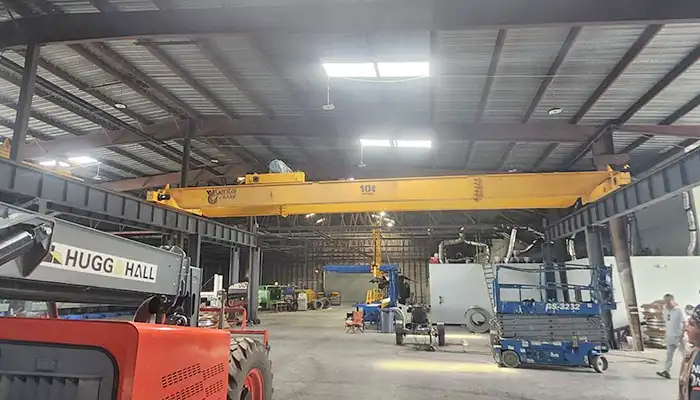
Affordable 10 ton double girder overhead crane with CD/MD hoist trolley, built for U.S. standards, ideal for construction and industrial lifting
Free consultation to Confirm Parameters & Specifications and Get
Latest Crane Price & Crane Rate.
- Types of overhead cranes : _______?
- Optional: Overhead travelling crane, goliath gantry crane,Slewing jib crane, Single girder or double girder crane,small portable crane or kbk crane, etc.
- Capacity of overhead crane: _______?
- Optional: 0.25ton, 0.5 ton, 1 ton, 2 ton, 3ton, 5 ton, 10 ton,15ton, 20ton, 25 ton, 30ton,35ton, up to 550ton, etc.
- Crane span & lifting height : _______?
- Crane travelling length : _____?
- Control of overhead crane:_______?
- Optional: pendant/ remote/cabin control
- Voltage supply of overhead crane:_____?
- Eg,: 380V50/60HZ,3Phase or others,etc.
- Application/usage of crane:_______?
- Eg,: Steel mill, ,injection mold, cement,stone, concrete,granite, general manufacturing, etc.
Just leave a message via the contact form and our hoist and crane engineer will contact you with in 24working hours.
Get In Touch
